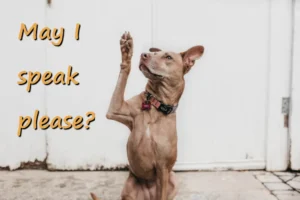Teaching puppies to have gentle mouths is one of the essential skills every pup parent should master. Without proper bite inhibition, playful nibbles can turn into painful nips, making training and socialization tricky.
To teach bite inhibition to puppies, focus on using positive reinforcement techniques that reward gentle interactions while discouraging hard bites. Start by offering toys for them to chew and provide immediate feedback when they bite too hard, gradually teaching them to control their mouths. There’s so much more to this process than just a basic approach, and hidden strategies await you in the details below!

Create Positive Associations
Building a positive connection with your puppy is crucial for teaching bite inhibition. The goal is to make gentle play rewarding and enjoyable, so your pup understands that being soft and calm leads to fun. Using treats and toys effectively can reinforce this behavior.
Start during playtime; if your puppy nips, immediately stop the interaction and say a firm “ouch.” This simulates a yelp similar to how littermates would react. After you pause the play, redirect your puppy’s attention to a designated chew toy. When they engage properly, offer treats, praise, and petting to reinforce that gentle play is the right choice.
Additionally, it’s vital to use a variety of toys to keep things exciting. Instead of just one favorite toy, rotate between different ones. This keeps your puppy engaged and encourages them to seek softer play without being bored. Remember, patience is key—this process may take time, but with consistent positive reinforcement, your puppy will soon learn that gentle play leads to more fun and treats.
Use Redirection Techniques
Redirecting your puppy’s biting behavior helps them channel their energy into more appropriate outlets. Instead of scolding, focus on guiding them to the right objects. Think about it this way: dogs don’t inherently know what’s right or wrong until they’re taught.
When your puppy starts nipping, calmly redirect their attention to a toy or chew item. Offer something they can bite into—preferably something that’s designed for chewing, like a Kong or rope toy. This not only helps protect your skin but also reinforces the idea that biting should only happen with the right items.
A key aspect of redirection is timing. The moment you feel a nip, offer the toy immediately to create a strong association between the action and the correction. If your pup engages with the toy instead, lavish praise and maybe even a few treats. Over time, they’ll recognize that playtime involves toys and not human hands.
Importantly, consider creating a “biting box” filled with appropriate chew toys. This gives you a designated area to bring out toys when biting starts, making it easier to stay consistent. The more predictable you are in these situations, the quicker your puppy will catch on.
Employ Yelping or Whining
Yelling or whining when your puppy nips can be an effective way to convey discomfort. The instinctive reaction often mirrors how littermates respond to rough play. When your puppy bites too hard, let out a high-pitched yelp or whine to signal that it hurts. This vocalization mimics what they’d hear from other dogs and can help them understand their bite is too strong.
It’s essential to keep these yelps genuine and not overly exaggerated; you want your puppy to recognize it as a cue for their behavior, not a game. After you yelp, pause for a moment to allow them to process what just happened. If they withdraw or stop biting, that’s a positive sign! Encouraging gentle play afterward reinforces the idea that softer mouths lead to more fun interactions.
As a bonus tip, if your puppy continues to nip despite your yelping, redirect their energy with a toy. Use positive reinforcement to reward them for playing gently instead. This approach helps them learn that appropriate mouth pressure gets them lots of affection and attention.
Introduce Time-Outs
Time-outs can be a game-changer for teaching bite inhibition. When your puppy bites too hard, calmly remove them from the situation. This doesn’t mean scolding them; instead, it’s about giving them a bit of space to chill out and reflect. Puppies often don’t realize they’re playing too roughly, and a brief break can help them manage that energy.
Consider timing your time-outs after a few warning signs of overexcitement—like excessive barking or jumping. Place them in a safe, quiet area where they can calm down. Aim for about 30 seconds to a minute; this timeframe helps them connect their action with a consequence without lasting distress.
A unique angle here is to establish a clear signal for the time-out, such as a simple phrase like “too much!” This creates consistency in training. Over time, your pup can associate that signal with the need to calm down, making them more aware of their actions.
By reinforcing appropriate play with gentle supervision and timely consequences, you help your puppy learn valuable lessons about bite inhibition while keeping interactions positive.
Reinforce Gentle Play
Teaching a puppy bite inhibition starts with understanding their natural behavior. Puppies explore the world with their mouths, so it’s all about guiding them gently. Whenever your pup plays and uses a gentle mouth, shower them with praise. Celebrate those soft nibbles by using treats, verbal encouragements like “good boy/girl,” and affectionate petting. This positive reinforcement builds a strong connection between gentle play and rewards in their mind.
If they start getting too enthusiastic, yelp in a playful tone or let out a gentle “ouch.” This mimics the sound that a littermate might make if bitten too hard, getting your puppy’s attention. Then, pause the play for a moment to let them ponder. By doing this, they learn that being too rough means playtime is over. Keep redirecting their energy to appropriate toys or activities to channel their excitement properly, always reinforcing the softer interactions.
Socialize with Other Dogs
Exposing your puppy to adult dogs can be a game-changer for understanding bite inhibition. Puppies learn so much from older dogs, particularly about boundaries during play. Arrange supervised playdates where your puppy can interact with well-mannered adults. This setting allows them to see firsthand how other dogs communicate and play, including when to back off or be gentle.
You’ll notice that adult dogs often react differently to rough plays, either by withdrawing or gently correcting the puppy. This teaches your pup that there are limits to playfulness, and they begin to adjust their own behavior in response. Keep the sessions short and positive; a tired puppy is likely to be a well-behaved one!
Additionally, consider puppy classes for structured socialization. These environments provide safe spaces for puppies to learn with supervision, giving them ample opportunities to practice gentle interaction and receive guidance.
Monitor Playtime
Observing your puppy’s playtime is key to teaching bite inhibition. Keep a close eye on their interactions, as this is when puppy social skills develop. Look for moments when play gets too rough; if your puppy bites too hard, you’ll want to intervene gently but firmly.
When play turns into a wrestling match and the biting intensifies, it’s time for a pause. Use a verbal cue like “Ouch!” to communicate that the biting is too intense. This often mimics the reaction their littermates would have, helping them learn acceptable boundaries. After stopping the play, redirect their energy to a toy or another activity. Offering a plush toy can help them associate good chewing habits with appropriate items.
Keep in mind the importance of energy levels. If your puppy seems overly excited, consider introducing short breaks during playtime. This helps to reset their energy and reinforces calm behavior. Regularly monitoring and guiding their interactions will lay a strong foundation for a well-mannered adult dog.
Fun Facts About Puppy Behavior
Puppies bite for numerous reasons, primarily stemming from natural instincts and playfulness. They don’t have hands to explore the world, so their mouths serve as important tools. Chewing and biting help them learn about texture, temperature, and even taste.
One intriguing fact is that puppies develop bite inhibition through interactions with their littermates. When one puppy bites too hard, the recipient often yelps and withdraws. This teaches the biter to soften their mouth. If your puppy’s been separated from littermates too soon, they might need some extra training to learn proper biting behavior.
Also, consider that biting isn’t just about aggression; it’s often a symptom of teething. Puppies can feel discomfort, and chewing provides relief. Having appropriate chew toys on hand can be tremendously helpful. These toys should be soft yet durable, easing their discomfort while safeguarding your belongings.
Understanding these quirks can help you navigate your puppy’s biting tendencies more readily and reinforce positive habits.
Unique Tools for Training
Training a puppy isn’t just about commands—it’s about communication and understanding. To help with bite inhibition, certain tools can make the process smoother and more effective.
Interactive toys can be game-changers. Look for toys designed for teething or those that can withstand rough play. These toys often encourage biting and chewing in a way that isn’t harmful to your fingers. Choose options that reward gentle play, helping your puppy learn to control the pressure of their bite.
Clickers are fantastic for reinforcing good behaviors. Pairing a clicker with treats can help your puppy associate gentle play with positive reinforcement. When they bite softly, capture the moment with a click and follow up with a treat. This builds a clear connection between the behavior and the reward.
Soft fabric training bites can also serve as a great tool. These allow you to practice bite inhibition in a controlled way. When your puppy nips or bites hard, offer them the fabric instead of your hands. This teaches them what is acceptable to chew on while preventing injury to your skin.
Lastly, consider puppy training classes that incorporate bite inhibition as part of their curriculum. Being in a controlled environment with other puppies helps them learn boundaries in a safe space under the guidance of a professional trainer. This social setting is invaluable, teaching them appropriate play behavior.
Unique Insight : Using a squeaky toy can add a fun twist to your training sessions. The noise can capture your puppy’s attention and encourage them to engage without using their teeth on you. When they bite too hard, the fun of play should stop. This immediate feedback reinforces the lesson that gentle play keeps the fun going.
Incorporating these tools into your routine not only helps with bite inhibition but also makes training a more enjoyable experience for both you and your puppy.
Alex, a passionate animal lover, has experience in training and understanding animal behavior. As a proud pet parent to two dogs and three cats, he founded AnimalReport.net to share insights from animal experts and expand his knowledge of the animal kingdom.




